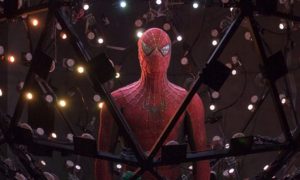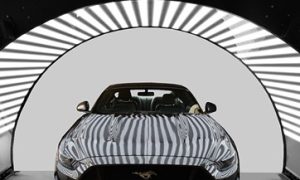Welcome!
Computational Imaging and Machine Vision Seminar, Fall 2025
3 Credits | Offered Fall 2025 on main Campus (Meinel Building 432) and via Arizona Online
Tuesdays and Thursdays 2pm – 3:15pm
 |
 |
 |
|
Computational illumination is used in the movie industry to render live actors into digital environments [1] |
So-called “structured light” systems are critical in industrial inspection, e.g., to detect defects in car bodies [2] |
Holographic and light field 3D displays have a wide range of applications in Augmented and Virtual Reality [3] |
Course website: https://wp.optics.arizona.edu/opti596/
Instructor: Prof. Florian Willomitzer
Lab website: https://www.optics.arizona.edu/3dim
Target group:
This course is designed for graduate students in Optics, Electrical Engineering, Computer Science, or similar fields of study. The students should have a strong interest in Computational Imaging and its associated disciplines, including Computer Vision, Image Science, Graphics, Optical Metrology, Information Theory, and more. Besides being motivated to understand the basic principles, students should be excited about the practical applications in various domains such as industrial inspection, VR/AR/MR, robotics, medical imaging, remote sensing, automotive sensing, metrology, forensics, or cultural heritage preservation.
Prerequisites:
This course has no specific prerequisites and is open to all students with basic knowledge in at least one of the core areas mentioned above. Previous attendance of the courses OPTI-556 (“Computational Imaging”) and OPTI-600C (“Computational Photography”) is not required.
Course Description:
This course explores the emerging new fields of Computational Imaging and Machine Vision, which combine ideas from technical optics, Fourier optics, information theory, image processing, computer graphics, and computer vision. The course will introduce state-of-the-art topics in computational imaging and machine vision, such as different methods for 3D imaging, appearance capturing, imaging around corners, event sensing, light fields, holographic displays, and much more!
The course will be held in a “part-lecture, part-seminar” -style that gives the students the opportunity to contribute actively and to sharpen their presentation skills. The instructor introduces the students to the core topics in a course “lecture session”. At the end of each lecture session, important shortcomings or open questions of the introduced methods are formulated. The students will find the answers to these problems by reading and presenting related papers. The instructor will provide a pre-selection of papers, but students are also welcome to present papers of their choice that are related to the topic.
Besides the technical aspects of each method and the related papers, the course will also focus on teaching students how to give a good presentation, which means that different presentation styles and techniques will be discussed as well.
The presented technical topics will be tailored to the background of attending students to achieve the best possible learning outcome. The “pool” of technical topics includes:
- Active and Passive Triangulation, Structured Light 3D imaging
- Appearance capturing and Photometric Stereo
- Time-of-Flight imaging, Imaging Around Corners and through Scatterers
- Light field imaging, Plenoptic Representations, Aperture Synthesis
- 3D Imaging of Specular Objects, Deflectometry
- Event Cameras, Motion Processing
- Interferometry, Holography, Lensless Imaging, wavefront sensing
- Light Transport, Direct and Global separation
- Color, Hyperspectral Imaging, and Compressed Sensing
- Light field Displays and Holographic Displays
- Neural Radiance Fields
- Differentiable imaging methods
- … and many more
A detailed course schedule will be published on the course website before the first lecture.
IMPORTANT: Number of allowed students for this course is limited. Please contact the instructor in case you have been placed on the wait list.
Grading:
There will be no midterm or final exam.
Course assignments will consist of at least two paper presentations and the related technical discussions.
Students will need to prepare a few discussion points along with their presentation, that will be brought up with the class after the presentation is finished. Presenting students are expected to guide and lead “their” discussion sessions.
Course format:
The course consists of “lecture sessions” and “presentation sessions.” New topics are introduced in the “lecture sessions.” Eventually, students prepare presentations about topics of their choice, which are held in the “presentation sessions.”
Live attendance (in-person or via zoom for distance students) during the “presentation session” is mandatory (see attendance policy below). The final schedule of “lecture sessions” and “presentation sessions” depends on the number of students and will be published closer to the beginning of the Fall semester.
Attendance Policy and recording:
In-person attendance of students is always preferred (and recommended!) to foster vivid discussions and an enjoyable course environment for both students and instructor.
Lecture sessions will be recorded and can be watched later.
Live attendance of students during all presentation sessions is mandatory to facilitate a vivid discussion. Not attending presentation sessions can result in failing the class. Students with conflicts must contact Prof. Willomitzer well in advance to discuss possible solutions.
Distance Students:
Lecture sessions and presentation sessions will be streamed live via zoom.
This course is open to distance students, as long as they are able to attend the presentation sessions live via zoom. This is a mandatory requirement. Lecture sessions can be watched later.
More questions? Feel free to contact Prof. Willomitzer: fwillomitzer@arizona.edu

